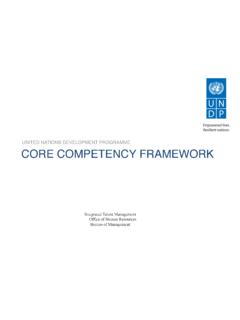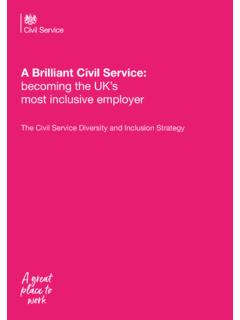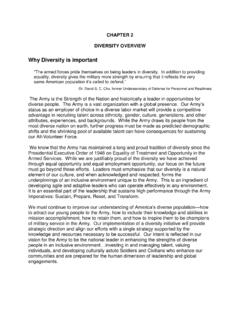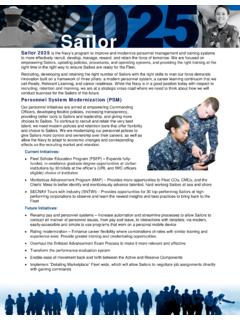Transcription of Talent matters - Deloitte US
1 Talent mattersHow a well-designed Talent experience can drive growth in emerging marketsDeloitte Consulting LLP s Human Capital Talent Strategies practice has helped organizations glob-ally align their business and workforce strategies to achieve their enterprise goals through five key business triggers: mergers & acquisitions, rapid business growth, retention, employee engage-ment, and workforce planning & analytics. We work to gain a deep understanding of employee populations and help organizations see their workforce as a value driver. From there, it s all about creating and implementing solutions that put the right people with the right skills in the right roles at the right time.
2 Our solutions are powered by extensive research and data across the entire Talent management lifecycle through Bersin by Deloitte . We approach Talent management as an investment in programs, processes, and technologies that delivers a measurable return in improved business performance. Contact the authors for more information or read more about our Talent Strategies practice on and Bersin by : The Talent experience | 2A three-step approach to increasing Talent management maturity | 5 What to do, where? Specific actions for each emerging growth market | 9 Using the three-step approach to help improve maturity in each geography | 12 Conclusion: Next steps | 23 Endnotes | 24 About the authors | 26 About the contributors | 27 Acknowledgements | 28 Contacts | 28 How a well-designed Talent experience can drive growth in emerging markets1 Introduction: The Talent experienceBUSINESS leaders and Talent professionals have long intuitively known that investments in Talent management drive business results.
3 Yet while the positive effects of this investment are real, measuring the impact of Talent management on business outcomes has proven elusive. Our re-cent findings illustrate that organizations with higher levels of Talent management maturity tend to perform better on critical Talent and business outcomes. Importantly, these findings hold true not only for global organizations but also for organiza-tions in major emerging growth markets including India, China, and Brazil. Historical approaches to Talent management which see Talent management as a collection of transactions or services (for example, paying people, conducting annual appraisals) often fail to provide competitive advantage to today s organizations.
4 To be in a position to reap the benefits that Talent man-agement maturity offers, organizations globally and in emerging growth markets should instead view the Talent experience as a networked, customizable system with individuals and their relationship with the organization at the center. A new high-impact model of Talent managementWe recently examined the Talent practices of a sam-ple of organizations representative of Global 2000 (G2000) organizations1 and developed our Bersin by Deloitte Talent Management Maturity Model2 (see figure 1). We then compared that model to three specific growth markets (India, China, and Brazil),3 analyzing the business and Talent results of organizations in all markets.
5 We found that while the path to mature Talent management may differ across markets, it can improve Talent and business outcomes for all organizations. As shown in figure 1, the vast majority of companies in all markets are low in maturity (levels 1 and 2) and are not realizing the Talent and business advan-tages of more mature Talent management. Compa-nies in these levels are primarily focused on achiev-ing excellence within individual Talent management practices (for example, Talent acquisition, perfor-mance management, learning, and leadership de-velopment). Talent matters2In contrast, high-maturity (levels 3 and 4) Talent management organizations have better business and Talent outcomes.
6 These organizations tend to view Talent as critical to their business-unit and corporate strategies and are intent on building a relationship with and an ecosystem for people to enable them to be successful. Therefore, these or-ganizations do not limit their focus to basic Talent management operational excellence. Instead, they build a Talent experience that encourages a culture of growth, insight, understanding, engagement, and communication. Practically speaking, this means that high-maturity organizations intentionally design technology sys-tems, processes, and practices that all work together to enable employees to have the information, capa-bilities, behaviors, and resources they need, when they need them.
7 Further, these organizations are increasingly developing their capability to listen at scale to the feedback of employees, so that they can rapidly customize their approach to workers, the work itself, or the University Press | : Bersin by Deloitte , Deloitte Consulting LLP, Talent activitiesLevel1 Critical Talent growthLevel 2 Managed Talent relationshipsLevel 3 Inclusive Talent systemLevel 4 GlobalIndiaChinaBrazilClear, targeted, and well-communicated Talent strategy Fully developed and integrated Talent activities aligned to desired strategic outcomes Relationships with Talent are systemic and tailored Progressive diversity and inclusion approach reflected in policies and employee experienceClear Talent strategy and analysis-based understanding of the workforce Nascent execution of systemic Talent relation-ships Targeted.
8 Integrated, and effective leader growth activities Strong learning culture Moving beyond compliance-based diversity and inclusion activitiesIncreasingly clear Talent strategy for critical Talent segments Emerging perspective on systemic Talent relationships Effective at implementing essential Talent activities Learning and leadership activities more targeted, prominent, and integrated Other Talent processes more sophisticated and integratedAlmost no strategy used to direct Talent management activities Little understanding or interest in systemic Talent relationships Essential Talent activities ( , performance management, Talent acquisition) in place but often inconsistent or lacking intention Talent activities often siloedFigure 1.
9 The Bersin by Deloitte Talent Management Maturity Model: Comparisons across markets10%9%2%2%19%12%6%8%59%76%91%89%12 %3%1%1%How a well-designed Talent experience can drive growth in emerging markets3 Figure 2. The best versus the rest the strong performance of mature Talent management organizations5 Outcome typeOutcome nameOdds of level 3 and 4 organizations scoring in top quartile of performance outcome compared to level 1 and 2 organizationsG2000 IndiaChinaBrazilBusinessMeeting or exceeds financial times more times more times more likelyEqually likely6 Improving processes to maximize times more times more times more times more likelyAnticipating change and responding effectively and times more times more times more times more times more times more times more likelyEqually likely6
10 TalentCoaching and developing people for better times more times more times more times more likelyManaging performance times more times more times more times more likelyIdentifying and developing times more times more times more times more likelyAssessing and selecting the right times more times more times more times more likelyLevels 3 and 4 = high maturity; levels 1 and 2 = low maturitySource: Bersin by Deloitte , Deloitte Consulting LLP, University Press | THE BENEFITS OF Talent MANAGEMENT MATURITYAs part of our research, we analyzed the relationship between Talent management maturity and eight metrics4 (figure 2).















